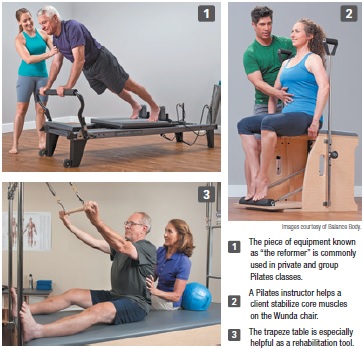Pilates for Beginners
Embraced by dancers and physical therapists, Pilates is for everyone at any age.
Pilates is a low-impact, joint-friendly method that invigorates mind and body. It was originally a one-on-one training system done on a mat and also on specialized machines developed by Joseph H. Pilates in the early 1900s. He originally called his system “Contrology” and preached about the benefits of doing his exercises with full concentration and control.
Pilates (pronounced Pea-LAH-tease) is a total body workout, best known for how effectively it develops core muscles. In the method, the core is called the “powerhouse,” because every movement is done with greater stability when it comes from a powerful center.
“Without a strong core, loss of balance can occur,” explains physical therapist Ellen Wilson, Director of Therapy Services, UCLA Department of Rehabilitation. “Almost all Pilates exercises incorporate core strengthening. Pilates movements also carry over to functional movement, so improvement is seen in everyday activities.”
Joseph Pilates has said in 10 sessions you’ll feel the difference, in 20 sessions you’ll see the difference, in 30 sessions you’ll have a whole new body. While that may sound like a big marketing promise, if you take two or three sessions per week for several weeks, it’s really not such a far-fetched claim. Like anything in life, you get out of it what you put into it.

Welcome to the Machines
Most people are introduced to Pilates in group mat classes. But to truly understand and gain the benefits of Pilates, private sessions with a certified Pilates instructor on the machines can’t be beat. Your body is worth the investment. And these sessions provide an unprecedented opportunity to get to know your body better, and feel better in it.
Joe Pilates created several pieces of exercise equipment. The main spring-based machines are the Reformer, Wunda Chair, and the Trapeze Table (also called the Cadillac).
The concept of working with spring-based Pilates machines is similar to working with flexible bands or tubing. The idea is to control the motion as you push, pull, twist or bend. The advantage of working with the spring-based machines is that they support and challenge your movements, and make it easier for you to find and develop core muscles.
Pilates Mat Work
Joe’s original teachings include 34 exercises performed in a sequence. Most classes teach a dozen or so movements until they are mastered and then new ones are added. It’s important in the method to do each exercise correctly. Of course, no one can do these exercises perfectly the first time, which is why instructors offer preparatory exercises and modifications. It’s vital to approach the method with a beginner’s mind and do these foundational exercises. Not doing so can lead to injuries. Pilates exercises point out your weaknesses thereby providing clear knowledge on what needs to be improved. Through Pilates, you can learn how to assess your own body’s capabilities, and what you need to do strengthen specific areas.
Regardless of level, a complete class should include exercises that move the spine in all directions—forward, backward, side-bending, and twisting.
From the Hundred to Swan, Saw, and Teaser, each exercise requires your full attention to get the most out of it. As you progress, the exercise doesn’t change but your relationship to it does. Skilled athletes can make his or her sport look easy, but lots of practice hours are needed to achieve such beauty and grace. You, too, can become stronger, move more gracefully, and feel more at home in your body through Pilates.
Common Principles for Mat and Machine
No matter where it is done, Pilates has several key principles. In general, the emphasis is whole body integration with a focus on quality of movement over quantity of repetitions.
The following six concepts are considered fundamental to the work:
- Pilates wrote “Above all else, breathe.” The general rule is inhale to prepare for the movement; exhale as you move.
- This is a mind and body method where all movements are intentional. Think about and feel your body as you move.
- Exercises are typically done slowly, especially in the beginning. Avoiding momentum requires a lot of control.
- The center, or core, is also referred to as the powerhouse in Pilates. Everything flows out from the center, that corset of muscles that wraps around your torso and includes back, abdominal, hip, and shoulder girdle muscles.
- As in ballet, tennis and other sports, Pilates asks for precise movements. This concept requires knowing where your body is in space (called proprioception).
- Pilates exercises are fluid not statically held, encouraging freedom of movement.
Joseph Pilates was a self-educated movement master. His concepts benefit people worldwide. He wrote two books where he passionately describes his work and philosophy, Return to Life through Contrology and Your Health.
“The exercises are adaptable to all levels of fitness, and can be progressed as you improve,” explains Wilson. “Pilates is also low impact, which is better for seniors with arthritis or painful joints.”
Pilates truly is for every body, at any age. It meets you where are, and can take you where you want to go. Look for instructors certified in equipment and mat (comprehensive certified) and who have been teaching for several years.


 Keep Walking to Lower Your Depression Risk
Keep Walking to Lower Your Depression Risk  Exercises For Mobility
Exercises For Mobility  Living with Dementia Means Having a Greater Fall Risk
Living with Dementia Means Having a Greater Fall Risk 
Through Pilates, you can learn how to assess your own body’s capabilities, and what you need to do strengthen specific areas.
© Mathayward | Dreamstime.com